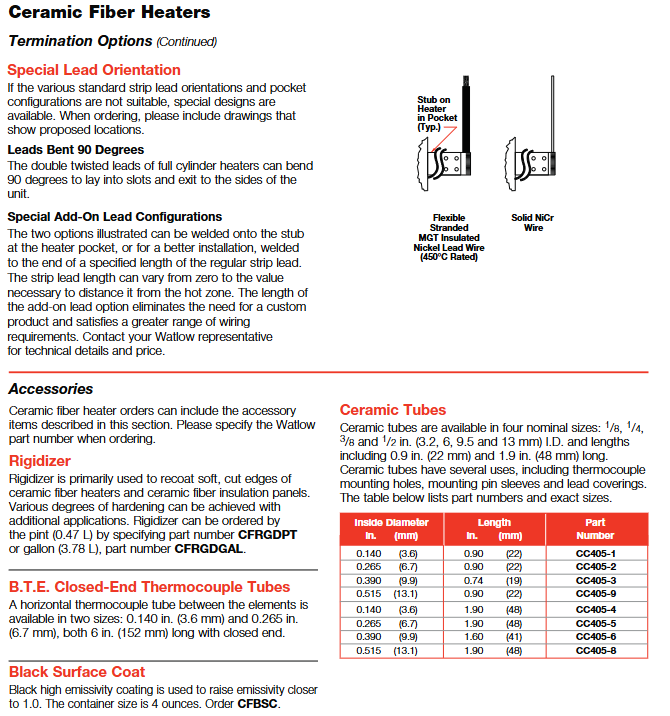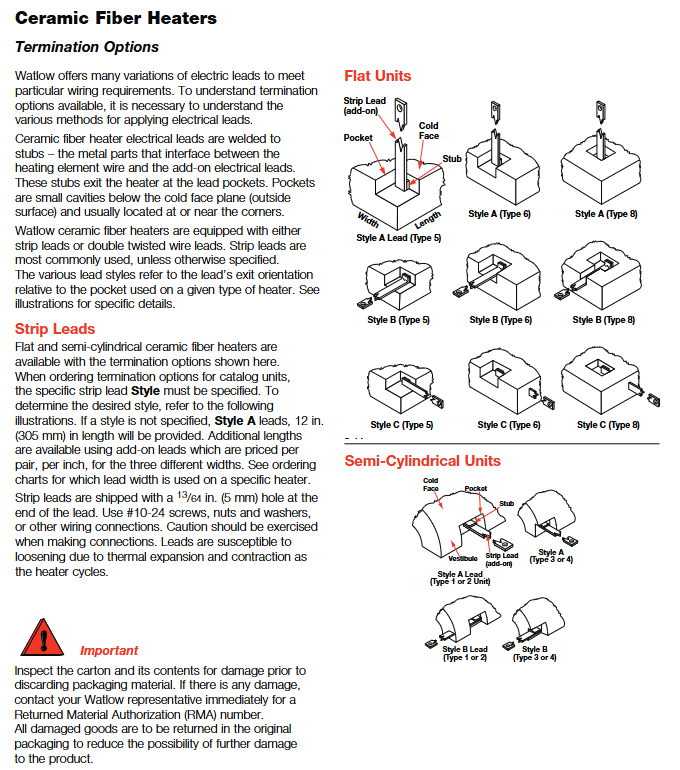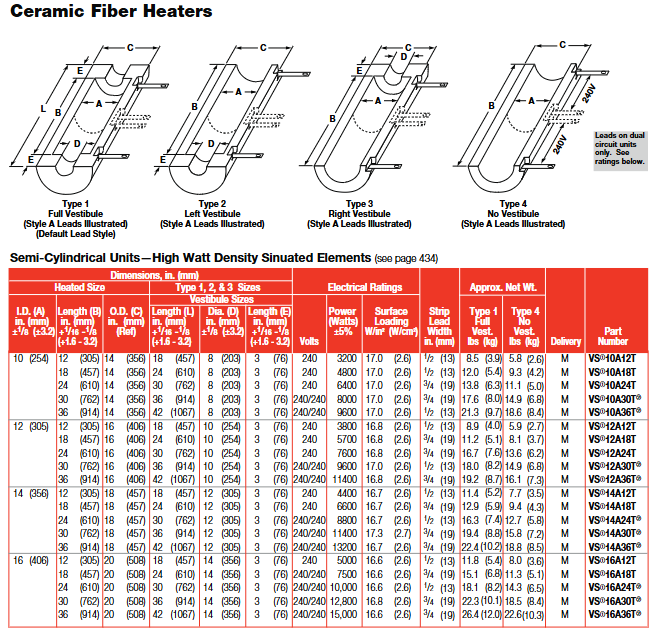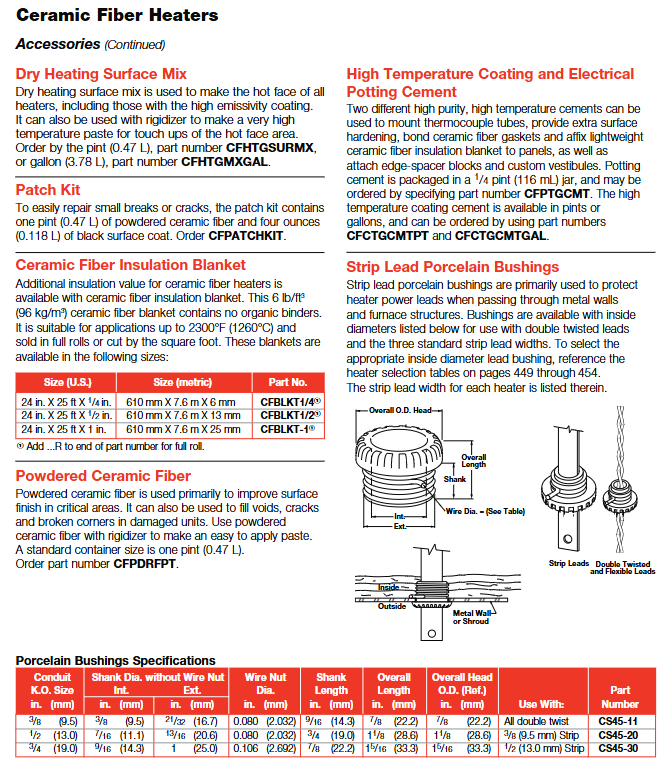

K-WANG


Watlow Ceramic Fiber Heater
Watlow Ceramic Fiber Heater
Product Core Overview
The Watlow ceramic fiber heater is a radiation type heater designed specifically for high-temperature scenarios. The core consists of an alumina silica ceramic fiber insulation layer and built-in heating elements, which have the characteristics of low quality, high insulation, and strong thermal shock resistance. Its maximum working temperature can reach 2200 ° F (1204 ° C), with a power density range of 5-30 W/in ² (0.8-4.6 W/cm ²). It only works through radiation heat transfer and can directly adapt to common power supply voltages without the need for transformers. It is widely used in industrial scenarios such as high-temperature furnaces, metal melting, semiconductor processing, and glass ceramic processing.
Core advantages:
High temperature adaptation: far exceeding the temperature limit of traditional heaters, suitable for extreme working conditions of 815-1204 ° C.
Efficient and energy-saving: Low quality insulation materials (10-15 lb/ft ³ density) heat up rapidly, and energy is concentrated on the load rather than self loss.
Flexible structure: Supports various forms such as flat, semi cylindrical, and fully cylindrical, and can customize multi-faceted integrated structures to adapt to complex installation environments.
Durable and reliable: inorganic adhesive and ceramic coating design, resistant to thermal cycling and chemical corrosion (except hydrofluoric acid, phosphoric acid, and strong alkali).

Core product configuration and features
(1) Types and differences of heating elements
The heater provides 5 core component configurations, suitable for different power densities and application scenarios:
Component type, structural characteristics, key advantages, power density improvement, applicable scenarios
Embedded Sined components are embedded inside ceramic fibers, divided into flat/V-shaped insulation with large thickness and strong thermal stability. The V-shaped insulation is 27% higher than the flat insulation in medium high temperature and medium power density scenarios, suitable for large-sized flat/semi cylindrical devices
Exposed Sined components are exposed on the surface of ceramic fibers, and the temperature difference between the flat/V-shaped components and the cavity is small, resulting in a long lifespan. The V-shaped components have a 20% increase in surface area and large inner diameter compared to flat components, and require rapid heating scenarios
Embedded Coil: a coil element embedded in complex curved surfaces, suitable for fitting small customized chambers, operating under high voltage, low current, low power density, and low duty cycle conditions, suitable for small tube furnaces
(2) Product Form and Specifications
Basic form
Flat panel: Supports four types: Type 5 (full heating), Type 6 (side insulation), Type 7 (end insulation), and Type 8 (full edge insulation), with sizes ranging from 4 × 6 in to 36 × 36 in.
Semi cylindrical: Type 1 (full vestibule), Type 2 (left vestibule), Type 3 (right vestibule), Type 4 (no vestibule), with an inner diameter of 1/2 inch to 8 inches and a length of 6-42 inches.
Full cylindrical shape: with an inner diameter of 1/2 inch to 8 inches and a length of 6-12 inches, suitable for small tube heating scenarios.
Customized molding: It can mold box shaped structures with up to five integrated sides, supporting complex curve and polygon designs.
Key specification parameters
Voltage: Standard 60/120/240 VAC (± 5%), customizable up to 600 VAC or three-phase wiring scheme.
Power: 60-11500 W per unit, supporting multiple units for combined expansion. High power density models (suffix "T") have a power density of 14.6-17.2 W/in ².
Dimensional tolerance: Heating area ± 1/16 in (± 1.6 mm), outer diameter ± 1/8 in (± 3.2 mm), wall thickness standard 2 ± 1/4 in (51 ± 6 mm).
(3) Core functions and protection
high-temperature stability
Within 24 hours of first use (1600-2200 ° F), there may be a shrinkage of ≤ 4%, which can be compensated for by factory pre firing treatment or on-site filling of ceramic fiber cotton gaps.
Ceramic fiber material does not contain organic binders, and there is no smoke or combustion risk when heated to 300 ° F (150 ° C) for the first time.
Auxiliary function options
High emissivity coating: Black surface coating (part number CFBSC) with an emissivity close to 1.0, improving radiative heat transfer efficiency.
Thermocouple installation: Supports embedded ceramic tubes (0.140-0.265 in inner diameter), can be arranged close to components, and accurately monitors hot spot temperatures.
Lead protection: Provides options such as ribbon leads (601 alloy 600), flexible leads (nickel material), etc. The lead length can be adjusted from 0-42 inches, and is equipped with ceramic sleeves to protect against high temperature oxidation.

Installation and usage specifications
(1) Key installation requirements
Fixed method: Priority should be given to mechanical fixation such as pins, clamps, and overlapping edge clamping to avoid adhesion (which cannot adapt to the thermal expansion and contraction of metal structures).
Heat dissipation and insulation: A backing insulation blanket (recommended density of 6 lb/ft ³, part number CFBLKT series) is required to improve energy efficiency and reduce external surface temperature (external temperature can be controlled within 450 ° F under 2200 ° F conditions).
Space reservation: When installing multiple units, a shrinkage gap should be reserved, and the gap should be filled with loose ceramic fibers after the first use.
Environmental protection: Avoid contact with pollutants such as oil and lubricants. Ceramic fiber porosity is greater than 90%, and the infiltration of pollutants can damage heating elements.
(2) Wiring and safety regulations
Lead wire treatment: The lead wire should be kept away from high temperature areas and connected by crimping. Regularly check for looseness caused by thermal expansion and contraction.
Temperature control: Low quality fast response thermocouples must be used (recommended distance from heating surface ≤ 1/16 in) to avoid self damage of the heater due to lack of temperature control.
Fault protection: Equipped with semiconductor fuses (such as Bussmann 170M series), with a short-circuit current rating (SCCR) of 200kA, in compliance with UL 508 safety standards.
(3) Maintenance and Repair
Cleaning: Regularly clean the surface dust with compressed air to avoid accumulation that affects heat dissipation.
Repair: Minor mechanical damage can be repaired using a specialized repair kit (CFPATCHKIT), which includes ceramic fiber powder and black coating. The use of non original adhesives is prohibited.
Replacement: If the heating element is damaged, the entire heater needs to be replaced, and the built-in element cannot be repaired separately.

Selection and Accessories
(1) Selection of core dimensions
Temperature and power density matching: Under high temperature conditions (>1800 ° F), the power density needs to be reduced to avoid exceeding performance limits (refer to the product performance curve to ensure that the operating conditions fall within a safe zone).
Form adaptation: Select flat/cylindrical/customized type according to the shape of the equipment chamber. For semi cylindrical equipment with an inner diameter greater than 5 inches, V-shaped sine elements are preferred.
Voltage and wiring: The 240V standard model adopts dual element parallel connection, and can be customized with 480V/277V or three-phase internal wiring schemes.
(2) Key accessories
Accessory type, function, usage, recommended model
Insulation blanket enhances insulation effect and reduces external temperature CFBLKT1/4 (6mm thick) and CFBLKT1 (25mm thick)
Thermowell fixed thermocouple, electrically isolated CC405 series (inner diameter 3.6-13.1mm)
Hardening agent repairs cutting edges, enhances surface hardness CFRGPPT (pint pack), CFRGDGAL (gallon pack)
Ceramic sleeve protection lead or fixing pin CC405-1 (3.6mm inner diameter), CC405-9 (13.1mm inner diameter)
Repair kit for small area damage CFPATCHKIT (including ceramic powder and coating)
Typical application scenarios
Recommended Configuration Core Value for Industry Application Scenarios
Metal processing melting furnace, insulation furnace, metal transmission line semi cylindrical/customized forming heater, high emissivity coating, high temperature resistance, fast heating, suitable for metal high-temperature processing needs
Semiconductor wafer processing equipment, CVD reactor flat embedded coil components, precise temperature control, low pollution, strong thermal stability, avoiding affecting process accuracy
Glass ceramic glass forming furnace, ceramic sintering furnace, fully cylindrical/multi-faceted integrated molding, high power density bonding chamber structure, uniform radiation, improving product consistency
Laboratory and R&D small-scale experimental furnaces, analytical instruments, small-sized fully cylindrical (inner diameter 3/4-2 in) rapid heating and cooling, suitable for frequent start stop test scenarios

- YOKOGAWA
- Energy Access
- Renewable Integration
- Energy Subsidies
- Energy and Water
- Net zero emission
- Energy Security
- Critical Minerals
- A-B
- petroleum
- Mine scale
- Energy and Gender
- Covid-19
- man-machine
- Reliance
- ADVANCED
- SEW
- ProSoft
- WATLOW
- Kongsberg
- FANUC
- VSD
- DCS
- PLC
- Sewage treatment
- cement
- Yaskawa
- Woodward
- BOSCH Rexroth
- MOOG
- General Electric
- American NI
- Rolls-Royce
- CTI
- Honeywell
- EMERSON
- Automobile market
- xYCOM
- Motorola
- architecture
- Industrial information
- New energy
- electricity
- Construction site
- HIMA
- ABB
- Rockwell
- Schneider Modicon
- Siemens
- MAN
- GE
- TRICONEX
- Control Wave
- ALSTOM
- AMAT
- STUDER
- KONGSBERG
- MOTOROLA
- DANAHER MOTION
- Bentley
- Galil
- EATON
- MOLEX
- Triconex
- DEIF
- B&W
- ZYGO
- Aerotech
- DANFOSS
- KOLLMORGEN
- Beijer
- Endress+Hauser
- schneider
- Foxboro
- KB
- REXROTH
- YAMAHA
- Johnson
- Westinghouse
- WAGO
- TOSHIBA
- TEKTRONIX
- BENDER
- BMCM
- SMC
-
GE Hydran M2-X Enhanced Monitoring
-
ABB REG316 1mrk000809-GA Numerical Generator Protection
-
ABB RED670 1MRK004810 Line differential protection
-
GE SR750-P5-G5-S5-HI-A20-R-E Feeder protection system
-
ABB PFTL301E-1.0KN 3BSE019050R1000 PillowBlock Load cells
-
Kollmorgen S33GNNA-RNNM-00 - Brushless Servo Motor
-
Kollmorgen 6sm56-s3000-g-s3-1325 - Servo Motor
-
Kollmorgen AKM52K-CCCN2-00 - Servo Motor
-
Kollmorgen PSR3-230/75-21-202 - Power Supply
-
Kollmorgen akm24d-anc2r-00 - Servo Motor
-
Kollmorgen AKM22E-ANCNR-00 - Servo Motor
-
Kollmorgen S60300-550 - Servo Drive
-
Kollmorgen B-204-B-21 - Servomotor
-
Kollmorgen AKM21E-BNBN1-00 - Servo Motor
-
Kollmorgen TT2953-1010-B - DC Servo Motor
-
Kollmorgen pa8500 - Servo Power Supply
-
Kollmorgen BDS4A-210J-0001-207C2 - Servo Drive
-
Kollmorgen TTRB1-4234-3064-AA - DC Servo Motor
-
Kollmorgen MH-827-A-43 - Servo Motor
-
Kollmorgen AKM24D-ACBNR-OO - Servo Motor
-
Kollmorgen 00-01207-002 - Servo Disk DC Motor
-
Kollmorgen AKM21C-ANBNAB-00 - Servo Motor
-
Kollmorgen PSR3-208/50-01-003 - Power Supply
-
Kollmorgen 6SM56-S3000 - Servo Motor
-
Kollmorgen DBL3H00130-B3M-000-S40 - Servo Motor
-
Kollmorgen 6SN37L-4000 - Servo Motor
-
Kollmorgen AKM65K-ACCNR-00 - Servo motor
-
Kollmorgen 6SM56-L3000-G - Servo Motor
-
Kollmorgen AKMH43H-CCCNRE5K - Servo Motor
-
Kollmorgen PSR4/52858300 - Power Supply
-
Kollmorgen KBM-79H03-E03 - Direct Drive Rotary Motor
-
Kollmorgen AKM33E-ANCNDA00 - Servo Motor
-
Kollmorgen U9M4/9FA4T/M23 - ServoDisc DC Motor
-
Kollmorgen AKM13C-ANCNR-00 - Servo Motor
-
Kollmorgen AKM43L-ACD2CA00 - Servo Motor
-
Kollmorgen AKM54K-CCCN2-00 - Servo Motor
-
Kollmorgen M-605-B-B1-B3 - Servo Motor
-
Kollmorgen AKD-P00606-NBAN-0000 - Rotary Drive
-
Kollmorgen 6SM-37M-6.000 - Servo Motor
-
Kollmorgen A.F.031.5 - Sercos Interface Board
-
Kollmorgen 918974 5054 - Servo PWM
-
Kollmorgen U12M4 - ServoDisc DC Motor
-
Kollmorgen AKD-B00606-NBAN-0000 - Servo Drive
-
Kollmorgen MV65WKS-CE310/22PB - Servo Drive
-
Kollmorgen 65WKS-CE310/22PB - Servo Drive
-
Kollmorgen EM10-27 - Module
-
Kollmorgen S64001 - Servo Drive
-
Kollmorgen CR03200-000000 - Servo Drive
-
Kollmorgen 6SM57M-3000+G - Servo Motor
-
Kollmorgen BDS4 - Servo Drive
-
Kollmorgen AKD-P00306-NBEC-000 - Servo Drive
-
Kollmorgen AKD-B01206-NBAN-0000 - Servo Drive
-
Kollmorgen STP-57D301 - Stepper Motor
-
Kollmorgen 6SM37L-4.000 - Servo Motor
-
Kollmorgen 44-10193-001 - Circuit Board
-
Kollmorgen PRDR9SP24SHA-12 - Board
-
Kollmorgen PRD-AMPE25EA-00 - Servo Drive
-
Kollmorgen DBL3N00130-0R2-000-S40 - Servo Motor
-
Kollmorgen S406BA-SE - Servo Drive
-
Kollmorgen AKD-P00607-NBEI-0000 - Servo Drive
-
Kollmorgen AKD-P01207-NBEC-0000 - Servo Drive
-
Kollmorgen CR03550 - Servo Drive
-
Kollmorgen VSA24-0012/1804J-20-042E - Servo Drive
-
Kollmorgen N2-AKM23D-B2C-10L-5B-4-MF1-FT1E-C0 - Actuator
-
Kollmorgen 04S-M60/12-PB - Servo Drive
-
Kollmorgen H33NLHP-LNW-NS50 - Stepper Motor
-
Kollmorgen A-78771 - Interlock Board
-
Kollmorgen AKM43E-SSSSS-06 - Servo Motor
-
Kollmorgen AKD-P00607-NBEC-0000 - Servo Drive
-
Kollmorgen E21NCHT-LNN-NS-00 - Stepper Motor
-
Kollmorgen cr10704 - Servo Drive
-
Kollmorgen d101a-93-1215-001 - Motor
-
Kollmorgen BDS4A-203J-0001-EB202B21P - Servo Drive
-
Kollmorgen MCSS23-6432-002 - Connector
-
Kollmorgen AKD-P01207-NACC-D065 - Servo Drive
-
Kollmorgen CK-S200-IP-AC-TB - I/O Adapter and Connector
-
Kollmorgen CR10260 - Servo Drive
-
Kollmorgen EC3-AKM42G-C2R-70-04A-200-MP2-FC2-C0 - Actuator
-
Kollmorgen BDS5A-206-01010-205B2-030 - Servo Drive
-
Kollmorgen s2350-vts - Servo Drive
-
Kollmorgen AKM24D-ANC2DB-00 - Servo Motor
-
Kollmorgen E31NCHT-LNN-NS-01 - Stepper Motor
-
Kollmorgen PRD-0051AMPF-Y0 - Servo Board
-
Kollmorgen TB03500 - Module
-
Kollmorgen 60WKS-M240/06-PB - Servo Drive
-
Kollmorgen M21NRXC-LNN-NS-00 - Stepper Motor
-
Kollmorgen H-344H-0212 - Servo Motor
-
Kollmorgen MCSS08-3232-001 - Connector
-
Kollmorgen AKM33H-ANCNC-00 - Servo Motor
-
Kollmorgen PA-2800 - Power Supply
-
Kollmorgen MTC308C1-R1C1 - Servo Motor
-
Kollmorgen PRDR0091300Z-00 - Capacitor Board
-
Kollmorgen BDS4A-206J-0024/01502D79 - Servo Drive
-
Kollmorgen S20330-VTS - Servo Drive
-
Kollmorgen S20250-CNS - Servo Drive
-
Kollmorgen SBD2-20-1105-WO - Servo Drive Board
-
Kollmorgen M405-C-A1--E1 - Servo Motor
-
Kollmorgen PRD-PB805EDD-00 - Servo Drive
-
Kollmorgen 6SM57S-3.000-J-09-HA-IN - Servo Motor
-
Kollmorgen AKM33H-ANCNDA-00 - Servo Motor
-
Kollmorgen PCB-00030200-04 - PCB
-
Kollmorgen H22SSLB-LNN-NS-02 - Stepper Motor
-
Kollmorgen BJRL-20012-110001 - Module
-
Kollmorgen BDS4A-206J-0001404A - Servo Drive
-
Kollmorgen H-342-H-0802 - Servo Motor
-
Kollmorgen CR10561 - Servo Drive
-
Kollmorgen BDS5A-206-00010-205B2-030 - Servo Drive
-
Kollmorgen BDS5A-206-00010-207B-2-030 - Servo Drive
-
Kollmorgen mcss08-3224-001 - Connector
-
Kollmorgen M-207-B-23-B3 - Servo Motor
-
Kollmorgen PRD-0041200Z-S0 - Encoder/Resolver Card
-
Kollmorgen MH-225-G-61 - Motor
-
Kollmorgen MT308B1-T1C1 - Servo Motor
-
Kollmorgen BDS4A-240J-0001604C83 - Servo Drive
-
Kollmorgen 6SM57-S-3000 - Servo Motor
-
Kollmorgen N-T31V-15-5B-6-MF3-FT1E-C251 - Actuator
-
Kollmorgen PRD-0051AMPA-X0 - Servo Board
-
Kollmorgen CF-SS-RHGE-09 - Cable
-
Kollmorgen DIGIFAS7204 - Servo Drive
-
Kollmorgen S30101-NA - Servo Drive
-
Kollmorgen DIGIFAS7201 - Servo Drive
-
Kollmorgen PRD-0051AMPA-Y0 - Servo Board
-
Kollmorgen AKM23D-EFCNC-00 - Servo Motor
-
Kollmorgen SE10000 - Servo Drive
-
Kollmorgen PSR4/5A-112-0400 - Power Supply
-
Kollmorgen AKM31H-ANCNC-01 - Servo Motor
-
Kollmorgen M-203-B-93-027 - Servo Motor
-
Kollmorgen CP-SS-G1HE-05 - Connector




